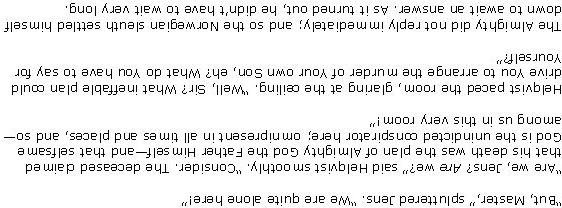A quite peculiar national trait in Norway is solving crimes during Easter. Publishers churn out series of books known as "Easter-Thrillers" or Påskekrimmen. Even the milk cartons change to have murder stories on their sides!
Two figures, one tall and one short, stride out of the darkness of a gloomy Friday afternoon, out of the city of Jerusalem and up the slope called the Hill of Skulls. A warm breeze off the Mediterranean stirs the tall man’s greatcoat to flap around him like the wings of a hawk. He pauses, holds out a hand; the shorter man bustles forward with a cigarette-case. The flare of a lucifer-match reveals the predatory features and glinting aristocratic monocle of the master ratiocinator himself: it is the great Norwegian detective Trygve Helqvist, along with his trusty manservant Jens, far from home and grappling with the most baffling case of his illustrious career!
Who Killed Jesus of Nazareth?
(a Trygve Helqvist mystery)
The man was already dead by the time Helqvist and Jens reached the hilltop. The cross had been taken down, and a crowd of onlookers was gathered. “Don’t move!” barked Helqvist. “This is a crime scene, and until further notice you are all under suspicion.” He turned to his hunched manservant. “Come, Jens. Let’s get a look at the victim.”
At the foot of the cross knelt an elderly man, cradling the dead man in his arms. “You! Old man!” snapped Helqvist. “Who are you, and what is your relationship with the deceased?”
“I am Joseph of Arimathea,” said the old man. “This Jesus of Nazareth, is... was... my friend. I came to cart the body away, to prepare it for burial.”
“Perhaps you have, and perhaps you haven’t,” mused Helqvist. “In any case, I will examine the body first.” He knelt down to look over the dead man, his monocle gleaming. “Take this down, Jens: deceased, Jesus of Nazareth. Palestinian male, between thirty and thirty-five years old. The body shows signs of torture on the extremities and back, and a large puncture in ventral abdomen—most likely from a spear-thrust.”
“The fatal wound, surely!” Jens ejaculated, scribbling furiously in his notebook.
“That’s a lie,” growled a nearby voice. A burly Roman centurion stepped between Helqvist and the dead man. “This man was a Jewish heretic, and we executed him by the book. You shouldn’t go sticking your nose into Roman government business, gumshoe.”
“And is it government policy to execute criminals by sticking them with spears?” said Jens.
“Forgive my dimwitted assistant, centurion,” said Helqvist. “The blood-spatter indicates that you are telling the truth—that the victim was already dead when stabbed. But it is a curious procedure, you must admit.”
The centurion looked uncomfortable. “You’ll have to ask my lieutenant about that. Longinus!” he called. “Tell the Norwegian what happened.”
Longinus, an awkward youth in an ill-fitting helmet, stepped forward. “We crucified him just as usual, sir. It’s just that he died so quick—well, it seemed odd to me, so I thought I’d best make sure he was really dead.”
“So there you have it,” said the centurion. “Official cause of death, suffocation due to crucifixion. All by the book. You’ve got no case, Helqvist.”
“Perhaps not,” replied the hawkish sleuth coolly. “But is crucifixion the usual punishment for heresy?”
“Well, no,” muttered the centurion. “The official charge was treason.” He leaned close. “Just between you and me, the locals was really putting the screws to Governor Pilate. Old Joseph, he’ll tell you. He’s in with them Sanhedrin. The deceased was getting up their noses something fierce, strutting around calling himself the Son of God.”
“Surely he was!” piped up Longinus.
The centurion rolled his eyes. “See what I have to deal with?”
Helqvist simply nodded. “I have no further questions at this time, centurion. But don’t leave town.” He turned next to a big man who sat on a nearby rock, weeping. “What’s your name, fellow?”
The big fellow turned his tear-stained face upwards. “P-Peter,” he said.
Helqvist’s monocle twinkled. “I advise to answer my question truthfully, sir. What is your real name?”
The burly man winced. “Simon. My name is Simon. He called me Peter.”
“The dead man?”
“Yes. He was my teacher, and my friend. And what he said was true; he was the Son of God.” Simon hung his head. “Although I denied it, to save my own skin.”
“How many associates did this man have?”
“Many believed, but there were only twelve of us who traveled with him,” said Simon. “Although one betrayed him. It was one of our own, Judas Iscariot, who turned him over to the Romans. He didn’t even resist.” He broke down in tears again. “He said it was all God’s plan.”
“Another piece of the puzzle,” mused Helqvist. “Very well, Simon Peter. Do not leave Jerusalem; I may wish to question you again.”
Back at the inn, Jens said, “It seems a complex conspiracy, Master. The Jewish Sanhedrin, fearing the growing influence of the man Jesus, planted a spy in his camp, this Judas fellow. That Arimathean is a follower of his, but he was powerless to stop them. As he continued to inconvenience them, the Sanhedrin sought to have him put to death. Lacking the authority to execute anyone themselves, they used Pilate as their cat’s-paw, pressuring him to write a trumped-up treason charge.”
“Oh, my simple-minded manservant,” laughed Helqvist. “You are overlooking one simple fact—this was murder! And in that fact lies the clue to the identity of the murderer. In fact, I have reason to believe that the killer is in this very room!”
How did Helqvist know? Turn the page over for the answer!


No comments:
Post a Comment